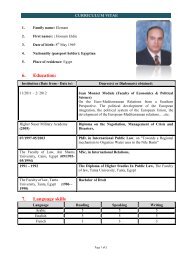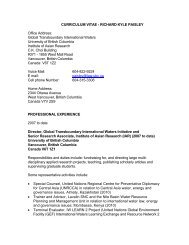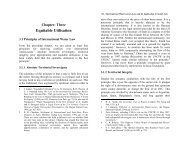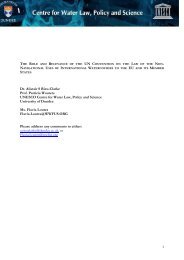Upreti, Trilochan, International Watercourses Law and Its Application ...
Upreti, Trilochan, International Watercourses Law and Its Application ...
Upreti, Trilochan, International Watercourses Law and Its Application ...
You also want an ePaper? Increase the reach of your titles
YUMPU automatically turns print PDFs into web optimized ePapers that Google loves.
194 / <strong>International</strong> <strong>Watercourses</strong> <strong>Law</strong> <strong>and</strong> <strong>Its</strong> <strong>Application</strong> in South Asia Prospects <strong>and</strong> Problems of Nepalese Water Resources / 195the development of water resources for the common benefit ofher people, <strong>and</strong> according to the principles of equity. Thoseprinciples were incorporated in the Mahakali treaty, which wasable to accommodate the divergent needs <strong>and</strong> interests of bothriparian nations. Nevertheless, due to disputes over theinterpretation of Article 3 of the said treaty, which provides forexisting consumptive use, Nepal’s consumptive use has beenspecifically defined in the treaty, whilst India’s consumptiveuse was not defined, <strong>and</strong> in the later stages was disputed (Nepalrecognised 248 cusecs while India argued for another 201cusecs), against the spirit of the treaty. Thus, the finalisation ofthe Detailed Project Report (DPR) could not be agreed upon,irrespective of numerous meetings held on several levels. It wasenvisaged in the treaty that the DPR should be finalised withinsix months of the ratification of the treaty; however, due to theposition taken by both states, it seems that it may take eightyears to finalise the DPR, which demonstrates the complexitiesassociated with it.It should be understood that early arrangements concerning thesharing of the Mahakali river were carried out under the SaradaBarrage agreement of 1920, but that due to its possible nonfunctioning,the river’s management was embodied in theMahakali treaty which replaced it. Simultaneously, the secondcomponent was the Tanakpur Barrage, which must beconsidered separately; however, the treaty providesarrangements in relation to the sharing <strong>and</strong> allocation of itsbenefit. Thus, the Mahakali river is to be developed in anintegrated manner so as to maximise the total net benefit fromsuch development. Either party should be entitled to equalbenefits <strong>and</strong> will thus share the costs in proportion to the shareof benefit which they actually receive. 44 The treaty has44 F. Marty, “The Pancheshwar Multipurpose Project on the MahakaliRiver (India-Nepal)” in P. Lang, (ed), Managing <strong>International</strong> Rivers:Problems, Politics <strong>and</strong> Institutions, Bern, European Academic Pub.,2001, pp. 161-219; also see A. B. Thapa, “Pancheshwar ProjectDownstream Benefits” (2003) in 23 Spotlight, July 11-17, pp. 1-3.recognised that the Mahakali is a boundary river on majorstretches, <strong>and</strong> to conclude a treaty on a boundary river on thebasis of equal partnership, it has defined their obligations,corresponding rights, <strong>and</strong> duties with regard to utilisation of thewaters of the said river. 45It is argued that this treaty provides a false impression that thetwo governments have taken a 'basin approach', because infuture the only project work which will be carried out is thePancheshwar Multipurpose Project (PMP); furthermore, otheroptions are negligible, except the Pancheshwar Barrage. 46Basically, the treaty establishes four main principles for design<strong>and</strong> implementation of the PMP. 47 The first principle is that thePMP will be designed to produce the maximum net benefits forboth countries in the forms of power generation, irrigation use,<strong>and</strong> flood control. The second principle of the project is that itwill be carried out in an integrated manner <strong>and</strong> the benefits willbe shared equally. The third principle is that both countriesshare the cost equally in proportion to the benefits accruing toeach. Finally the fourth principle is that a share of Nepal'senergy (half of the 6,480 MW) will be sold to India <strong>and</strong> itsprice shall be mutually agreed upon between the parties basedon the avoided cost principle. Generally, avoided cost refers tothe replacement cost of alternatives (thermal or nuclear). Thisobviously sets the maximum price of the cost of generation <strong>and</strong>transmission to the Indian border. A compromise suggested byNepal as a fair price is the sum of India’s current thermalreplacement cost <strong>and</strong> Karnali’s generation cost, divided bytwo. 4845 S. M. A. Salman & K. Uprety, "Hydro Politics in South-Asia: AComparative Analysis of the Mahakali <strong>and</strong> the Ganges Treaties"(1999) in 39 NRJ, p. 313; also see S. M. A. Salman & K. Uprety,Conflict <strong>and</strong> Cooperation on South Asia’s <strong>International</strong> Rivers: ALegal Perspective, the Hague: Kluwer <strong>Law</strong>, 2003, pp. 101-118.46 Article 3, 36 ILM, (1997), p. 537.47 Ibid. p. 533.48 D. Gyawali, Water in Nepal, Kathm<strong>and</strong>u: Himal Books, 2001, pp. 53-65.












